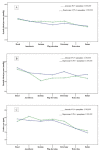Comparative split-mouth study of the anesthetic efficacy of 4% articaine versus 0.5% bupivacaine in impacted mandibular third molar extraction
- PMID: 24455059
- PMCID: PMC3892217
- DOI: 10.4317/jced.50869
Comparative split-mouth study of the anesthetic efficacy of 4% articaine versus 0.5% bupivacaine in impacted mandibular third molar extraction
Abstract
Objective: The purpose of this study was to compare the clinical efficacy of articaine at 4% (epinephrine 1:100,000) with bupivacaine at 0.5% (epinephrine 1:200,000) for surgical extraction of impacted mandibular third molars.
Study design: This was a randomized, double blind, split-mouth, clinical trial. Thirty-six patients took part and underwent extraction of 72 lower third molars. The variables studied were: anesthetic latency time, intra-operative bleeding, anesthetic quality, hemodynamic changes during the surgical intervention, anesthetic duration in the soft tissues, post-operative analgesia and post-operative pain at 2, 6, 12 and 24 hours using a visual analogue scale, as well as any need for additional rescue medication.
Results: Latency time was 2.0 minutes for articaine and 3.1 minutes for bupivacaine, with statistically significant difference (p<0.05). Bleeding was greater when bupivacaine was used (p<0.05) and anesthetic quality was greater with articaine (p<0.05). The duration of soft tissue anesthesia was longer with bupivacaine (p<0.05). Differences in post-operative analgesia, haemodynamic changes, post-operative pain and the quantity of rescue medication consumed were not statistically significant (p>0.05).
Conclusions: Articaine showed greater clinical efficacy than bupivacaine, reducing latency time, bleeding, anesthetic duration in the soft tissues and achieving higher anesthetic quality, requiring less reinforcement during surgery than bupivacaine. Key words:Articaine, bupivacaine, anesthetic efficacy, impacted mandibular third molar.
Conflict of interest statement
Figures
References
-
- Fardi A, Kondylidou-Sidira A, Bachour Z, Parisis N, Tsirlis A. Incidence of impacted and supernumerary teeth-a radiographic study in a North Greek population. Med Oral Patol Oral Cir Bucal. 2011;16:e56–61. - PubMed
-
- Chaparro-AvendaÒo AV, Pérez-GarcÌa S, Valmaseda-CastellÛn E, Berini-AytÈs L, Gay-Escoda C. Morbidity of third molar extraction in patients between 12 and 18 years of age. Med Oral Patol Oral Cir Bucal. 2005;10:422–31. - PubMed
-
- Fisher SE, Frame JW, Rout PG, McEntegart DJ. Factors affecting the onset and severity of pain following the surgical removal of unilateral impacted mandibular third molar teeth. Br Dent J. 1988;164:351–4. - PubMed
LinkOut - more resources
Full Text Sources
Other Literature Sources
Medical



